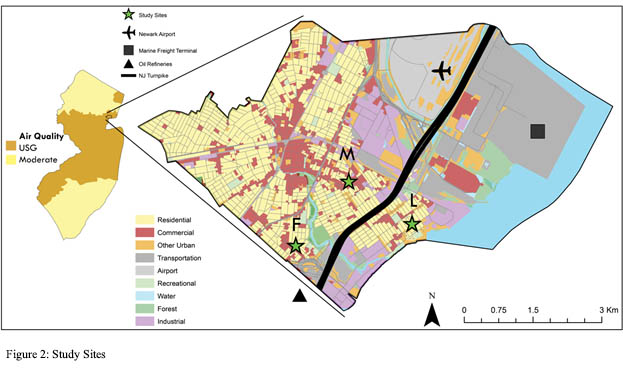A major local concern in highly urbanized regions worldwide is the effect of heat waves on the local population and infrastructure. An increasing incidence of extended periods of high ambient air temperatures and humidity threatens public welfare by increasing both outdoor and indoor heat stress and air pollutant exposures, and it challenges electric power systems by imposing an increased demand for air conditioning. Increased greenhouse gas emissions feed back to the climate system. We previously developed a regional-level coupled climate-human systems modeling framework that downscales global climate change predictions to greater New Jersey and simulates interactions among the regional economy, electric power system and real estate markets, with feedbacks to climate. Key phenomena of interest are heat waves and coastal flooding. This project extended the modeling framework to connect to the heat-wave-related concerns of local communities.
Specifically, this project added buildings and their occupants to the multi-level modeling framework previously developed, thereby introducing a novel, interdisciplinary perspective to the climate modeling community. The modeling framework links occupant responses to heat stress (e.g., opening windows, using air conditioners) to changes in indoor air quality (affected by outdoor air quality, building systems and their operation, and occupant activities) and electricity consumption. We performed field studies to measure and provide a basis for predicting how adaptable different population segments are to heat waves as a function of personal, building-level, and locational characteristics, thereby identifying thresholds beyond which climate-related stresses become human health disasters. Building systems and associated community health strategies change on the decadal time scale, as new buildings are built, existing buildings are renovated, and community health actors adopt new practices. Activities included five major tasks: (1) preparatory work, (2) field work, (3) model calibration, (4) generalizing to the regional building stock, and (5) sharing results. The fieldwork took place during May – October 2017, followed by the modeling and analysis phase. Our community partner for the duration of the project was the Housing Authority of the City of Elizabeth, NJ, which operates affordable housing in a location with the worst air quality in New Jersey. In this collaboration, we jointly sought to understand how can our poorest urban households better cope with an increasing number of heat waves?
To help address this question, the project advanced a data-related agenda to achieve dual uses of increasingly ubiquitous consumer-grade sensors. The standard use is to serve consumer needs by informing them about their own local health status and environmental context. The second, and more difficult use, is to serve researchers and the larger community by crowd-sourcing high quality data.
In conclusion, the project accomplished an advanced modeling-related agenda to entrain helpful representations of human behavior into models of engineered and natural systems where behavior affects system performance. We established a co-simulation capability linking occupant behaviors and embeddedness in supportive social networks to building physics models that predict energy consumption and indoor air quality.
- Research products
- This project is funded by NSF grant AGS-1645786.
- Project personnel: Clinton Andrews, Anne Marie Carlton, Enrique Curchitser, Frank Felder, Ruikang He, Gedi Mainelis, Deborah Plotnik, Jennifer Senick, Ioanna Tsoulou, and additional students.
- For more information contact Clinton Andrews



